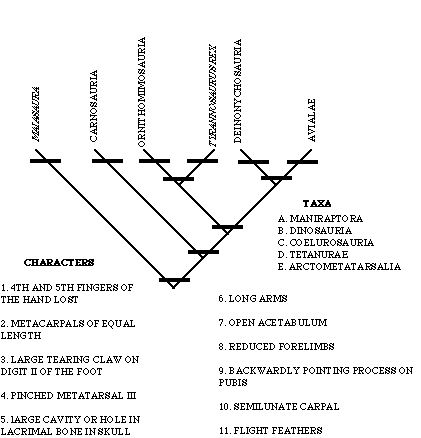
PRACTICE FINAL EXAM
NAME ______________________________________________
NOTE: The real exam is designed to take 1 hr. You will have a total of 3 hr to finish it. It will be significantly longer than this practice exam!
There will be 6 sections:I. True - False
II. Multiple Choice
III. Short Answer
IV. Short Essay
V. Dinosaurian Relationships
VI. Dinosaurian Anatomy
1. Dinosaurs did not have to regulate their body temperature because they were all very large.
True - False2. In endothermy the main method of thermoregulation is behavioral.
True - False3. The diplodocid sauropods include Apatosaurus .
True - False4. The Carnosauria includes birds.
True - False5. Dinosaurs have high predator/prey ratios
True - False
1. The air sac system in birds function mostly as:
a) as accessory lungs to remove more oxygen.2. The Maniraptora include:b) protection against the cold.
c) a way of lowering body mass
d) passageways allowing a one-way direction of air through the lungs
a) Deinonychus, birds, and Velociraptor3. The semilunate carpal is:b) Plateosaurus, Oviraptor, and Archaeopteryx
c) Ornitholestes, Allosaurus, and Struthiomimus
d) Velociraptor, Coelophysis, and Dilophosaurus
a) a phase of the moon4. Archaeopteryx is of:b) a bone in the hand producing a rocking, bird-like motion of the wrist
c) a bone in the hand which evolved in birds to permit flight
d) one half of the wishbone
a) Late Triassic age5. Iridium is:b) Early Jurassic age
c) Late Jurassic age
e) Early Cretaceous age
a) a radioactive element useful in dating Cretaceous rocksIII. SHORT ANSWER: Give a one to three sentence answer.b) an element indicative of a supernova at the end of the Cretaceous
c) an element found in a clay layer at the Cretaceous-Tertiary boundary
d) an element diagnostic of asteroid impacts
1. How can we tell that sauropods did not walk with a sprawling
gait and posture?
2. Why do big animals lose heat slower
than small animals?
3. What are Haversian canals and what is their importance?
4. Archaeopteryx is a tetanurine. Why?
5. Name three Judith River herbivorous genera and one carnivorous genus
of dinosaur that may have eaten them.
1. What is the evidence and what are the arguments that dinosaurs were
warm blooded and controlled their body temperature by internal means (i.e.
were endothermic homeotherms)? Be as specific as possible.
Impact theory of mass extinctionsUses of footprints
Evidence for the relationship of birds to dinosaurs
Effects of dinosaurs on climate
Dinosaurs of the Morrison Formation

 Return
to the Dinosaurs 2001 home page
Return
to the Dinosaurs 2001 home page